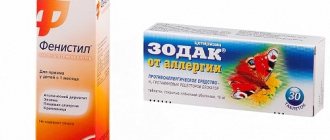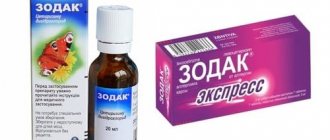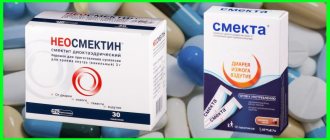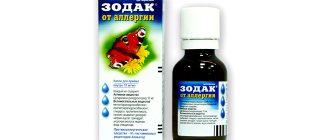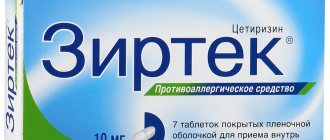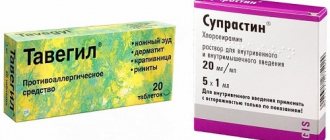Choosing a medication to treat allergies in a child is not an easy task. The range of antiallergic drugs in pharmacy stores is very wide. Many are sold without a prescription, but not all are suitable for treating allergies in children due to the presence of side effects or due to insufficient knowledge of the drug’s effect on the child’s body.
If we look at it in more detail, drugs whose main purpose is to treat allergies or relieve the main symptoms are divided into five groups:
- antihistamines;
- hormonal;
- antileukotriene;
- anti-inflammatory;
- immunomodulatory.
Each group has its own effect in the treatment of such a disease, and the choice of the type of medication can only be determined by the attending physician, who, after studying the patient’s clinical picture, is able to prescribe adequate therapy. In this case, the age and weight category of the patient are taken into account.
As a rule, children are prescribed to take Zyrtec or Zodac, each of which is good in its own way. These drugs have a blocking effect and prevent the development of allergy manifestations. The main component in both cases is cetirizine dihydrochloride.
Comparison, differences, what and who is better to choose
Despite the similar characteristics, there are some differences between them that need to be taken into account before purchasing. The main differences include the following:
- Compound. In addition to the same active ingredient, the auxiliary elements are different. For this reason, the effect on the body may vary.
- Price. Zodak is a more expensive remedy, its price is about 300 rubles for a pack of 30 tablets. The analogue will cost significantly less - about 70 rubles, which indicates its advantage.
- Contraindications. The first remedy is not recommended for children under six years of age. Cetirizine can be taken by children from one year of age under the supervision of a doctor.
Both drugs have proven themselves to be effective medications and have gained great popularity, so doctors often use them in their practice. According to some reviews, there is evidence that Zodak begins to act much faster, but causes more drowsiness. Another part of the patients notes that the effect on the body is absolutely identical, so there is no point in overpaying for an expensive product.
Despite the fact that the medications in question are dispensed without a prescription form, it is recommended to consult a specialist before use. Only he will be able to select the necessary treatment, depending on the individual characteristics of each organism.
Similarities and differences
Both anti-allergy drugs are 2nd generation histamine receptor blockers and contain the same active compound – cetirizine dihydrochloride
, and, accordingly, a single mechanism of pharmacological action. Histamine is a biogenic active substance released in the body in response to exposure to an allergen. To initiate an allergic reaction, histamine must bind to related receptors in various tissues. Cetirizine, contained in the anti-allergic drug, is a competitive histamine antagonist. This means that it is able to bind histamine receptors (make them inaccessible to histamine), thereby preventing the development of allergic reactions. This mechanism is the basis of the therapeutic effect of Zodak and Zyrtec.
Compositions
To determine how Zodac differs from Zyrtec in composition, you need to pay attention to their auxiliary components. Zyrtec tablets contain microcrystalline cellulose as a formative substance, as well as lactose, magnesium stearate and silicon dioxide. Zodak contains no cellulose (it is replaced by corn starch), and povidone instead of silicon dioxide. These components do not have a pharmacological effect on the body and are only necessary to give the drug the required dosage form, but if you have an intolerance or allergy to any of them, you should stop taking the corresponding drug.
Original or copy
Zyrtec is the original drug, Zodak is its generic version. The difference is that the first one is produced by the company that owns the patent, which initially synthesized and conducted comprehensive preclinical and clinical studies of the effectiveness and safety of the drug. Generic Zodac is a kind of “copy” of Zyrtec, having the same active substance, but produced by another company with manufacturing technologies that differ from the original one. The lack of costs for the pharmaceutical company for initial long-term studies explains the lower price of the generic Zodac compared to the original Zyrtec.
10 tablets
Release forms and indications for use
The dosage forms of the drugs are also identical - each of them exists in the form of tablets, solution (drops) and syrup for oral administration. Zodac or Zyrtec drops are intended for oral administration by both adults and children over 6 months of age.
Since the drugs are structural analogues, they have the same indications. Zodak and Zyrtec are used for:
- dermatoses of an allergic nature;
- allergic rhinitis;
- hives;
- hay fever;
- Quincke's edema.
The drugs have similar pharmacokinetic parameters, that is, the rate of development of their therapeutic effect is almost identical. According to reviews from practicing doctors, both drugs are equally effective in reducing the severity of allergy symptoms such as itching, swelling, muscle spasms, redness, and lacrimation.
TOP cheaper analogues for children and adults
Cetirizine tablets are produced in Vietnam (Danafa) and in Macedonia (Replekpharm). One package contains ten tablets, each containing 10 milligrams of the active substance. The price is 69 rubles. Packages of 20 tablets are also available, which will cost from 89 rubles and more.
This is one of the cheapest analogues of Zyrtec. Not recommended for treatment of children under six years of age.
Cetirinax is another fairly cheap analogue. Sold in packs of seven tablets. The price for one package starts from 77 rubles.
Parlazin is used in the treatment of rhinitis, conjunctivitis, and urticaria. The active ingredient is cytirizine hydrochloride. Produced by the Russian company “Egis”. The cost of a package of 10 tablets 0t is 128 rubles and more.
Zodak is produced by the Czech company Zentiva. A package of ten tablets will cost from 138 rubles. The main active ingredient is cetirizine.
Levocyteresin Sandoz uses levocyteresin. The package contains ten tablets, each containing five milligrams of the active substance. The price for one package is 239 rubles.
Suprastinex is an analogue that is produced in Hungary. The active ingredient is levocetirizine. Each tablet contains 5 mg of this substance. A pack of 7 tablets costs 253 rubles.
Cost of medicines: is there a difference in price?
What is the price of Zyrtec? The cost of the medication depends on the form of release and the pharmacy chain. After all, suppliers sell goods at one price, and the store charges additional interest. Zyrtec drops, the price of which is approximately 350 rubles, have a volume of 10 milliliters. Tablets cost about 200 rubles for 7 pieces.
For the medicine “Zodak” (drops), the price ranges from 180 to 220 rubles. For this amount you can buy 20 milliliters of the drug. Tablets under this trade name can be produced in dosages of 5 and 10 milligrams of the active substance. 10 capsules of this medication cost approximately 150 rubles.
Why is there such a difference in price between drugs? The thing is that the medicine “Zodak” (drops), the price of which is indicated above, is produced in the Czech Republic. Capsules for oral administration are also produced there. The drug "Zyrtec" is produced in Belgium, Italy and Switzerland. This is what explains the high cost of the drug compared to its generic counterpart.
Effect of the drug
Zodak contains the active ingredient cetirizine, which has a strong antiallergic effect. This medicine is of a new generation, therefore it does not cause the same side effects as drugs from previous years, namely drowsiness and addiction. Cetirizine acts as a histamine H1 receptor blocker. It is this substance that successfully relieves swelling and itching.
One Zodak tablet contains 10 mg of cetirizine. An adult needs only one tablet per dose or ½ tablet twice a day to relieve allergy symptoms.
You can take the tablets regardless of meals. Like many other medications, Zodak for allergies is taken whole, without chewing, and washed down with a whole glass of water.
Attention! Doctor's consultation required!
For children under 6 years of age, it is better to give the medicine in the form of drops - 5 drops twice a day. This amount corresponds to 2.5 mg of active substance
Before taking, the drops must be diluted in water.
However, if the child has severe itching that makes him irritable, syrup can be used instead of drops. It contains a larger amount of cetirizine - 1 scoop of 5 mg contains 5 mg of the substance. Although the drug does not cause drowsiness in adults, the syrup can act as a sleeping pill on a child, and the child will fall asleep peacefully. For very young children, according to the instructions, the medicine is given only in the form of drops.
The drug begins to act in some patients within 20 minutes; in most patients, relief after taking the drug occurs within an hour.
Patient reviews
Ekaterina, 33 years old, Vladivostok: “I didn’t suffer from allergies before, but last winter red spots began to appear on my face, which were flaky and itchy. The itching was so severe that I decided to see a doctor. The therapist referred me to an allergist, who diagnosed cold urticaria. Zodak helped get rid of this problem. I took it 1 tablet 1 time a day. The symptoms disappeared quickly and did not bother me throughout the winter. Next time I’ll start taking the medicine with the first frost.”
Valentin, 49 years old, Yekaterinburg: “After I had bronchitis, I began to wake up every day with a runny nose. I had to consult an ENT specialist with complaints of sneezing, itching, nasal congestion and tearfulness. The doctor said that the runny nose was of an allergic nature and prescribed Zyrtec. I have kidney problems, so I took the medicine in reduced doses - 5 mg daily. I know that some patients need to take the drug less often - 5 mg every other day. To avoid adverse reactions, consult your doctor before starting treatment."
Irina, 31 years old, Irkutsk: “I gave both drugs to my children when allergies appeared. The eldest son, who is 10 years old, took tablets, and the youngest, who is 2.5 years old, took drops. The medications quickly relieved us of allergy symptoms, and there were no side effects (including drowsiness). It is better to discuss dosages with your pediatrician, as they depend on the age of the child.”
Side effects
1.
Gastrointestinal tract:
- Dry mouth;
- Symptoms of dyspepsia (flatulence, heartburn, belching, constipation, diarrhea, etc.);
- Nausea;
- Perversion of taste;
- Swelling and inflammation of the tongue;
- Increased salivation;
- Thirst;
- Rectal bleeding.
2.Central nervous system:
- Headache;
- Drowsiness;
- Fatigue;
- Excitation;
- Migraine;
- Aggression;
Allergic reactions to foods or hygiene products are common among young children. It’s rare that parents have not had difficulty treating skin rashes! The problem is complicated by the age of young patients. Their choice is limited to a small list of medications.
Most often, doctors prescribe Zodac or Zyrtec for a child, containing cetirizine.
Caring mothers pay attention to these drugs first of all, trying to figure out which of these drugs will be safer for the baby. So, Zyrtec or Zodac - which is better for a child and why?
Comparative analysis
The comparison table of Zodak and Zertek is as follows:
From the presented table it can be seen that the two drugs have the same active component, but there is a slight difference in the auxiliary elements included in their composition. However, these excipients do not have any therapeutic effect on the body and are intended to form the desired dosage form.
The only thing is that a person may have hypersensitivity to one of these substances, and then he should take this or that drug with caution.
Also, depending on the country of origin, medications may have different production technologies, degrees of purification, and, accordingly, shelf life. There are no other pharmacological changes.
The biggest difference between the two antiallergic drugs is their price. The cost of Zodak is almost two times cheaper than Zyrtec. In this regard, many doctors recommend their patients to purchase a cheap Zodak. Since this will not only save money, but also reduce the risk of purchasing a counterfeit. From an economic point of view, counterfeiting cheap drugs is less profitable smuggling than counterfeiting expensive drugs.
Many pharmacists claim that an expensive medicine has fewer contraindications than a cheap one. Therefore, people are often advised to buy more expensive medicines. However, this does not apply to the expensive Zyrtec and its cheap analog Zodac, since these two drugs have the same contraindications, namely:
- hypersensitivity to one of the components;
- children under one year of age;
- pregnant women;
- women who are breastfeeding;
- people over sixty-five years of age;
- patients suffering from renal failure;
- people with liver disease.
Also, alcohol and central nervous system depressants should not be taken together with antiallergic drugs.
Zodak for children
General provisions and rules for choosing a dosage form
This means that a child aged 1–2 years should be given Zodak only in the form of drops. A child aged 2 to 6 years can be given the drug in the form of drops or syrup. In this case, the choice of dosage form is determined mainly by the child’s taste preferences. For example, if a child calmly and without refusal takes drops or syrup, then he should be given Zodak in this form.
A child over 6 years old can be given Zodak in any form - tablets, drops or syrup. In this case, the choice of dosage form is also determined by the preferences of the child and the functioning of his gastrointestinal tract. If the child swallows the tablets well and they do not cause nausea or other unpleasant gastrointestinal symptoms, then you can give him the drug in this dosage form. If it is difficult for your baby to swallow tablets, then you should give him Zodak in the form of syrup or drops.
Use in children under one year of age
Experienced pediatricians recommend that infants do not give drops orally, mixing them into milk, water or mixtures, but drop them into the nose. With this method of using drops, the risk of developing side effects is reduced, and the strength of action is quite sufficient to relieve the manifestations of an allergic reaction. Pediatricians recommend instilling one drop of Zodak solution into each nasal passage twice a day.
If parents decide to give Zodak drops orally, then the following dosages should be observed, established for children of different ages:
- Children under 3 months
– give 2 drops once a day;
- Children 3 – 6 months
– give 3–4 drops once a day;
- Children 6 – 12 months
– give 5 drops once a day.
Zodak - instructions for use for children
The tablets must be swallowed whole, without biting, chewing or crushing in any other way, but with a small amount of still water. Before use, the drops are dissolved in a small volume of water, and the syrup is drunk in its pure form.
The dosage of Zodak for children is determined solely by their age and does not depend on the type or severity of the allergy. The dosages of various forms of drugs for children of different ages are given in the table.
| Child's age | Dosage of Zodak drops | Zodak syrup dosage | Dosage of Zodak tablets | Dosage Zodak Express |
| 1 – 2 years | 5 drops 2 times a day | Do not apply | Do not apply | Do not apply |
| 26 years | 10 drops once a day or 5 drops twice a day | 1 measuring spoon of syrup 1 time per day or 1/2 measuring spoon 2 times a day | 1/2 tablet 1 time per day | Do not apply |
| 6 – 12 years | 20 drops once a day or 10 drops twice a day | 2 scoops of syrup once a day or 1 scoop twice a day | 1 tablet once a day or 1/2 tablet 2 times a day | |
| Over 12 years old | 20 drops once a day | 2 scoops of syrup once a day | 1 tablet once a day | 1 tablet once a day |
Children suffering from renal failure should reduce the recommended age dosage by half. For children suffering from liver failure, the dosage of Zodak is selected individually, if necessary, reducing it by half relative to the standard for their age.
Release form and scope
Both products are produced by manufacturers in syrup, drops and tablets. Depending on the age, you can easily choose a release form convenient for the child. Syrup is best suited for children under 3 years of age - it has a pleasant taste.
You can get prescribed these drugs if your baby suffers from:
- allergic dermatitis;
- he was diagnosed with Quincke's edema;
- there are manifestations of urticaria;
- there is hay fever;
- there is rhinitis or conjunctivitis (characteristic allergic symptoms - frequent sneezing, lacrimation, severe swelling of the mucous membranes).
Side effects are extremely rare. Diarrhea may develop, headache, dry mouth, tachycardia may appear.
It is important not to self-medicate! Before going to the pharmacy, parents should make sure to visit the pediatrician in a timely manner.
Allergies or dermatitis in children are a fairly common problem that parents face. Among antihistamines, doctors often recommend two drugs - Zodac or Zyrtec, as interchangeable ones. But the difference in price makes you wonder which one is better, because every loving parent wants the medicine to be not only effective, but also to have no or minimal side effects. Therefore, many people wonder what is better for their child - Zodac or Zyrtec? Let's try to answer it.
Let's start with pharmacological properties. These two medications prevent an increase in the amount of histamine in the child’s body, a tissue hormone. Under normal conditions, this hormone supports vital body functions. But with some diseases (hay fever, burns, frostbite, urticaria and other allergic reactions), as well as when the body is exposed to certain chemicals, the amount of free histamine increases. The drugs Zodak and Zyrtec contain the main active ingredient - cetirizine dihydrochloride, which blocks the increase in histamine H1 receptors. Both drugs help stop the course of allergic reactions and alleviate them, and have an antipruritic effect.
Zodak and Zyrtec are prescribed for the following ailments:
- and conjunctivitis (itching, sneezing, lacrimation, conjunctival hyperemia);
- hives;
- hay fever;
- other allergic dermatoses.
Zodak and Zyrtec are prescribed orally. These drugs are produced in the form of drops and tablets, and Zodak is also produced in the form of syrup, which is more convenient for children.
Zodac and Zyrtec - what's the difference?
If we compare side effects, they develop infrequently when taking these medications. The development of the sedative effect in the Zodak drug is less pronounced or not expressed at all. Among the undesirable reactions of the body to this drug, the following are noted: urinary retention, dry mouth, dizziness, fatigue, headache, dilated pupils, agitation, allergic reactions, tachycardia, diarrhea, flatulence and abdominal pain.
When taking Zyrtec, similar side effects on the body are possible. They also add blurred vision, rhinitis, pharyngitis, impaired liver function, and weight gain. But they develop extremely rarely. Thus, there are fewer undesirable effects on the body from Zodak.
Another difference between the antiallergic drugs Zyrtec and Zodak is the age restrictions for use. Zyrtec drops can be given to babies from 6 months, and children over 6 years old can already take tablets. Zodak syrup is not recommended for children under 1 year of age, and tablets for children under 2 years of age.
The prices for these drugs also vary. So, for example, Zodak in tablets costs from 135 to 264 rubles, and drops - from 189 to 211 rubles. The cost of Zyrtec is higher. Tablets can be purchased for 193–240 rubles, but drops are much more expensive – 270–348 rubles.
Some parents note that Zodak works faster and more effectively than Zyrtec. But, most likely, this depends on the individual perception of the drug by the child’s body.
Thus, if we compare Zodac and Zyrtec, we can note that they have many common characteristics. At the same time, there are differences - in side effects, age restrictions for children, as well as in the cost of drugs.
Answering the question whether it is possible to replace Zodac with Zyrtec, the answer is yes, because. these medications have the same antiallergic effect. But before you go to the pharmacy for medicine, consult your doctor. He will help you choose the best antihistamine for your child.
Zyrtec is an original antiallergic drug; it is produced in Belgium and Switzerland. The generic (analog) of Zyrtec for the active substance is Zodak (Czech Republic). In terms of 1 ml of active ingredient, this drug costs 10-12 times Zyrteca. Both drugs are prescribed for the same indications. “Zyrtec” and “Zodak” are good at easing the course or preventing the development of allergies. The drugs affect allergic reactions that are at an early stage of development. These drugs prevent the appearance of tissue edema, relieve spasms of smooth muscles, and significantly reduce capillary permeability. "Zyrtec" or "Zodak" is prescribed for seasonal or year-round allergic rhinitis and conjunctivitis, urticaria, itchy skin, and allergic. They can be taken for fever, angioedema, bronchial asthma, and Zodak is also prescribed for children over 6 months. The dosages are the same: both drugs need to be taken 10 mg once a day, or 5 mg twice a day. The medicine is pre-dissolved in water. The drugs are prescribed 5 drops a day for children 6-12 months old, 5 drops 1-2 times a day for children aged 1-2 years, 5 drops 2 times a day for children 2-6 years old, 10-20 drops per day - adults and children over 6 years old. In case of existing mild impairment of kidney function, one or another drug should be taken in a daily amount equal to 5 mg, and in case of severe impairment, a daily amount corresponding to 10 mg should be taken once every two days. How long it is necessary to take this or that drug must be determined by the doctor, individually in each case.
Zodak or Zyrtec syrup is also convenient to use. One measuring spoon of syrup corresponds to 5 mg of the drug.
Zyrtec or Zodac
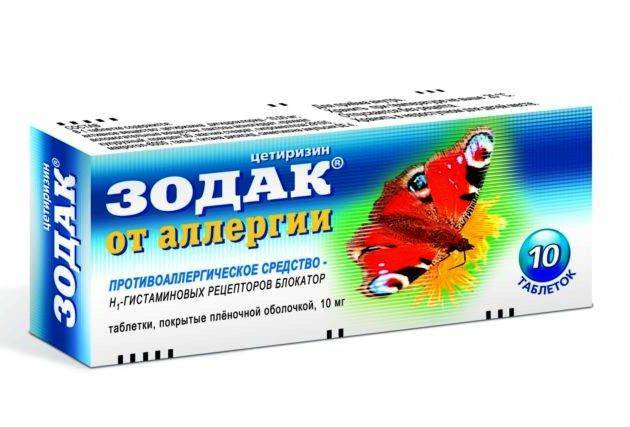
Zyrtec and Zodac are absolutely similar drugs. They differ in the country of origin and in the auxiliary components, each of which can cause an allergic reaction due to the body’s increased sensitivity to any of them. Zodak is a generic drug, produced in the Czech Republic. This means that there is a difference in the purification of the components used and production technology.
Significant clinical and pharmaceutical differences in the production of the drug are not allowed. But the cost varies significantly: Zyrtec drops are an expensive original drug. The significantly lower price of the Zodak in relation to it has its positive aspects: fakes are less common, since they are not economically profitable. Therefore, both drugs are interchangeable; when purchasing, the choice depends on financial capabilities.
In all cases where there are indications for the use of an antihistamine, it can only be used as prescribed by a doctor. The specialist will assess the severity of the condition, determine the presence of concomitant pathologies, and take into account the interaction of Zyrtec with other drugs received. Self-medication is dangerous due to serious side effects and contraindications. If all recommendations are followed, treatment will be effective and will take the shortest possible time.
Reviews from doctors
Valentina Chernyavskaya, pediatric allergist
I often prescribe Zyrtec to patients. It is an original medicine developed with the participation of European-level pharmacological companies. It is recommended to start using it for children from the 1st year of life. Zodak is very similar in effect, but is recommended for children 2 years and older. If the patient is confused by the price of the first drug, then I prescribe Zodak, with an appropriate personal dosage.
Konstantin Krasavko, allergist
I recommend that patients who come to me, especially those with serious manifestations of allergic reactions, undergo appropriate laboratory tests. Since both drugs have quite a large list of side effects and contraindications, for example, due to methylparabens in their composition, which can provoke negative reactions, this helps eliminate the possibility of negative effects. Therefore, I strongly advise you to take these medications, especially for children, with the prescription of a specialist doctor.
Indications for use
The indications for use of these antihistamines are the same:
- treatment of symptoms of allergic nasal and ocular rhinitis;
- urticaria and diathesis;
- itchy dermatoses resulting from an allergic reaction;
- seasonal conjunctivitis or rhinitis;
- Quincke's edema.
Zodak and Zyrtec are recommended for the same diseases, that is, the indications for the use of these drugs are the same
Drugs in this group are not intended to treat allergies, but solely to eliminate symptoms. To cure the disease completely, you will need to consult an allergist and undergo serious therapy.
Comparison of ease of use of Cetirizine and Zodak
This includes dose selection taking into account various conditions and frequency of doses. At the same time, it is important not to forget about the release form of the drug; it is also important to take it into account when making an assessment.
The ease of use of Cetirizine is approximately the same as Zodak. However, they are not convenient enough to use.
The drug ratings were compiled by experienced pharmacists who studied international research. The report is generated automatically.
Last update date: 2019-09-19 05:59:53
Zodak or Zyrtec which is better for a child?
Similarities
These drugs are commercially available in the form of syrup, drops, and coated tablets. Experts recommend taking Zodac or Zyrtec to treat the same ailments that are allergic in nature:
- dermatitis;
- rhinitis;
- conjunctivitis;
- hay fever;
- urticaria, etc.
Even the dosage when taking the above drugs is prescribed the same, with an emphasis on the patient’s age.
Distinctive features
If you more carefully analyze the composition of Zyrtec and Zodak, you will notice, although insignificant, a difference in the auxiliary components. However, this circumstance does not particularly affect the effectiveness and final therapeutic result. Before you buy another allergy drug, you should carefully check whether you have hypersensitivity to one of the auxiliary components.
Manufacturing plants producing Zodak are located in the Czech Republic. But Zyrtec is produced in Belgium, Italy, and Switzerland. This indicates that the possibility of differences in the degree of purification of the raw material, production process, etc. cannot be ruled out.
An equally important and significant difference between these medications is the cost. It is worth noting that the price of Zyrtec is quite high and is several times higher than the cost of Zodak. Moreover, instead of Zyrtec, you can buy a fake. And you can save a lot on buying a Zodak.
Of course, everyone decides for themselves whether Zyrtec or Zodak is better. Before making a choice, you should thoroughly study the instructions for use. At the same time, you should not make a decision on your own to replace an expensive original with an analogue. Don't forget that we are talking about the child's health. It is better to consult with a doctor who, as a professional, will select an allergy medication for you, based on your financial capabilities.
Use in childhood
Antihistamines are also used to reduce the severity of allergies and alleviate the condition for children. It is up to the pediatrician to determine whether Zodac or Zyrtec is better for a child with allergies. Both medications in tablet form can be prescribed to children from 6 years of age, drops are used for treatment at a younger age - from 6 months. In this case, in children from 6 to 12 months of age, drugs are used strictly as prescribed by a pediatrician.
Due to incompletely developed immunity, the impact of allergens on a child’s body can be unpredictable, so it is extremely important to seek professional advice in a timely manner. At the appointment, after eliminating contraindications, the doctor will calculate the individual safe dose of Zyrtec or Zodac for the child.
10 mg/ml
What to choose?
Thus, a comparison of the main characteristics of the drugs indicates the similarity of Zyrtec and Zodak; the same active substance in the composition determines the identical therapeutic effect. If you have a choice between two products, you should first of all take into account the presence of allergic reactions to auxiliary components and prices.
If lactose is poorly tolerated, Zyrtec will be a more suitable option, since it contains one tablet less (66 mg versus 73 mg in Zodak).
If we focus on cost, the original Italian Zyrtec (10 tablets) will cost almost one and a half times more than Zodak, produced by the Czech pharmacological company.
How to take Zodak and Fenistil
Each medicine has its own dosage regimen. How to use Zodak:
- In tablet form: adults and children over 12 years old should take 1 piece. 1 time per day, children from 6 months to 12 years old need to drink 0.5 tablets 2 times a day.
- In the form of drops: people over 12 years of age, as well as children aged 6-12 years, need to take 20 drops once a day. Children 2-6 years old should take 10 drops of the drug once a day; children aged 1 to 2 years should be given 5 drops of Zodak twice a day.
Fenistil should be taken as follows:
- Drops: patients over 12 years of age need to drink 20-40 drops three times a day. The recommended daily dosage for children over 1 month is 2 drops per 1 kg of child's weight per day. It is divided into 3 doses.
- Cutaneous emulsion, cream, gel: for children and adults, the drug needs to be distributed over the affected skin 2 to 4 times a day.
Medicines in tablet form must be taken with a sufficient amount of water.
The duration of treatment is determined for each patient individually.
Features of using Zyrtec
Zyrtec is also a product containing cetirizine , which prevents the appearance of swelling and spasms, both in the early and late stages of an allergic reaction.

If allergies occur, you need to take 1 tablet per day (20 drops) and expect the effect within an hour. The drug has a fairly long-lasting effect, more than a day. It is necessary to relieve the symptoms of rhinitis, as well as the treatment of conjunctivitis, urticaria, hay fever, Quincke's edema and allergic dermatoses.
Adults should take the medicine once a day, 10 mg , which is equal to one tablet or twenty drops; For children, it is best to divide the dose into two, since very often half the daily dose is enough to get the effect. Moreover, unlike the use of Zodak, a full dosage of Zyrtec is allowed for children from 6 years of age . Patients from 6 months to 6 years should reduce the dose in accordance with the table suggested in the instructions or the doctor's recommendations.
This medication is also contraindicated in patients during lactation, pregnant women and patients with intolerance to galactose or any components of the drug. Elderly people, children under 6 years of age, as well as those who suffer from impaired kidney function should exercise caution when taking it. It’s even better to consult a doctor first.
Unfortunately, this medicine has significantly more side effects. These include: dizziness, nausea, fainting, convulsions, emotional excitability, insomnia, depression, hallucinations, liver dysfunction. In addition, tachycardia, thrombocytopenia, urticaria, rhinitis, pharyngitis and much more may develop. Taking the drug can also cause anaphylactic shock. But experts say that side effects are extremely rare.
Therapeutic effect
This means that Zodak varieties block the functioning of histamine receptors, which is why histamine cannot bind to them and cause a cascade of biochemical reactions that cause allergic reactions, such as swelling, itching, redness, rashes, etc. The fact is that, regardless of the type of allergy, the final stage in the development of its clinical manifestations is histamine. After all, any allergen, once in the body, causes a cascade of reactions that lead to the production and release of large amounts of histamine into the tissues and bloodstream. And then it is histamine, provoking other cascades of biochemical reactions, that leads to the formation of swelling, itching of the skin, rashes, dilation of blood vessels, etc.
That is, it is histamine that is the substance that causes the development of various manifestations of allergic reactions, regardless of their cause. But histamine can only trigger allergy symptoms when it binds to histamine receptors on certain cells. If these receptors are blocked, then histamine will not be able to contact them and will not provoke the development of allergic reactions. Zodak, by blocking histamine receptors, prevents histamine from binding to them, which prevents the development of allergy manifestations.
2 - 3 days after production, histamine is destroyed, and the allergic reaction essentially stops completely. If after this the allergen does not enter the body again, then an allergic reaction will no longer develop.
Thus, Zodak is a powerful antiallergic agent that prevents and alleviates the course of already developed allergic reactions, relieving itching, reducing swelling and the severity of skin rashes. In recommended therapeutic dosages, the drug does not cause a sedative effect, so it can be taken by workers or students. In addition, an important advantage of Zodak is the lack of addiction to the drug, even during a long course of use.
The effect of the drug appears 20–60 minutes after administration and continues throughout the day.
Pharmacokinetics of Zodak
Absorption After oral administration, cetirizine is quickly and well absorbed from the gastrointestinal tract. The maximum concentration level is determined after approximately 30-60 minutes. Food intake does not have a significant effect on the amount of absorption, but in this case the rate of absorption is slightly reduced. Distribution Cetirizine is approximately 93% bound to plasma proteins. The Vd value is low (0.5 l/kg), the drug does not penetrate into the cell. The drug does not penetrate the blood-brain barrier. Metabolism Cetirizine is poorly metabolized in the liver to form an inactive metabolite. With 10-day use at a dose of 10 mg, no accumulation of the drug is observed. Excretion Approximately 70% occurs by the kidneys, mainly unchanged. The systemic clearance is about 54 ml/min. After a single dose of a single dose, the T1/2 value is about 10 hours. In children aged 2 to 12 years, the half-life is reduced to 5-6 hours. In case of impaired renal function (creatinine clearance below 11-31 ml/min) and in patients patients on hemodialysis (creatinine clearance less than 7 ml/min), T1/2 increases 3 times, clearance decreases by 70%. Against the background of chronic diseases and in elderly patients, there is an increase in T1/2 value by 50% and a decrease in clearance by 40%. Hemodialysis is ineffective.
Which drug is better?
Despite the fact that Zyrtec has many more contraindications and possible negative consequences, you should not be biased towards it.
The drug is effective, patients respond positively to it
You should be wary of contraindications: although both drugs are not recommended for a number of patients, they are not completely excluded, but are advised to simply adjust the dosage, this is where caution must be exercised
Zodak is preferred not so much because it has an advantage over its analog Zyrtec in some way, but because of its financial benefits. If you still have any doubts and do not know which medicine to choose, the best solution would be to consult a specialist doctor.
Compound similarities
The main active ingredient in both drugs is cetirizine dihydrochloride. They are considered analogues of each other and can be mutually replaced if the required product is not available in the pharmacy.
- hives;
- diathesis in children;
- itchy dermatoses;
- rhinitis;
- conjunctivitis caused by exposure to allergens;
- Quincke's edema.
Zodac and Zyrtec do not treat allergies. Their action is aimed only at eliminating the symptoms of the disease.
Manufacturers produce both drugs in the same dosage forms:
- drops containing 10 mg of active ingredient per ml;
- coated tablets, each containing 10 mg of cetirizine hydrochloride.
The liquid form of the drug is recommended for young children with symptoms of diathesis or urticaria, or other manifestations of allergies. After reaching the age of 6, you can take the pills. Adults are most often prescribed a tablet form of any of these medications.
The drugs begin to act in about 5 minutes and cope well with various manifestations of allergies in children and adults.
Contraindications
Medicines are not prescribed for individual intolerance to the components, breastfeeding, pregnancy, renal failure (end stage). An additional contraindication to taking tablets is hereditary galactose intolerance, glucose-galactose malabsorption syndrome or lactase deficiency.
Caution should be observed in elderly people, patients with chronic renal failure, epilepsy, increased convulsive readiness, predisposition to urinary retention
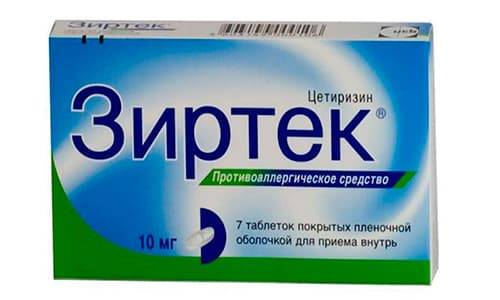
An additional indication for taking Zyrtec is urticaria.
Characteristics of the drug Cetirizine
second generation antihistamine . Prevents the development of allergic reactions and also alleviates accompanying symptoms. If the therapeutic dose is observed, it does not have a hypnotic effect. The effect of the drug lasts for 24 hours after administration. Available in the form of tablets and drops.
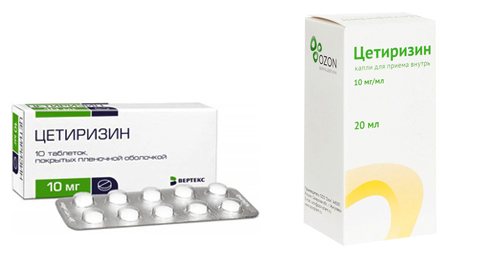
Indications for use are:
- Allergic conjunctivitis.
- An inflammatory process of the nasal mucosa resulting from exposure to irritants (allergens).
- Seasonal hay fever.
- Inflammatory lesions of the skin (dermatitis).
- Nettle fever.
- Acute angioedema.
Among the main contraindications are the following:
- Severe kidney failure.
- Period of pregnancy, breastfeeding.
- Increased susceptibility to incoming components.
Patients with chronic kidney disease and the elderly should take it with caution.
Possible adverse reactions include:
- Feeling of dryness in the mouth.
- Tendency to sleep.
- Headache, dizziness.
- Increased fatigue, loss of strength.
- Allergic reactions in the form of skin rashes.
- Disruption of the normal functioning of the stomach, accompanied by painful digestion.
During treatment, it is recommended to refrain from engaging in activities that require increased concentration and speed of reactions. Driving in motor vehicles should also be limited.
Drops
Most anti-allergy medications are available in tablet form. But there are antihistamines in the form of drops. Pharmaceutical companies may offer Zyrtec (drops) or Fenistil (drops). This form is very convenient for children who find it difficult to swallow a large tablet, or people who have difficulty swallowing solid objects for psychological reasons.
In order to make an informed choice, you need to conduct a comparative analysis of both drugs and find out how Fenistil and Zyrtec differ. The instructions for use for children have some differences, knowing which will make making a choice much easier.
The drug "Fenistil" in drops:
- is a first generation antihistamine;
- its effect is milder than that of Zyrtec;
- Fenistil can be used as a preventive measure for allergies or to relieve symptoms that have begun;
- When taken, side effects such as dizziness and nausea are possible;
- drops can be used from 1 month, but the product in gel form can also be used for newborns.
"Zyrtec" drops:
- is a second generation antihistamine;
- It can be used after the child reaches 6 months;
- Zyrtec is a drug with a strong effect, so it is better to use it when the clinical picture of symptoms has already fully developed.
Most often, the choice between drops is made taking into account the baby’s age: “Fenistil” is used to treat allergies in newborns, and “Zyrtec” is recommended for use in children only after six months of age.

Thus, analogues of allergy drugs have a certain similarity. However, it is known that in humans one substance can have excellent therapeutic effects, while another can produce a large number of side effects. Therefore, the choice of drugs that will have to be taken according to indications for a long time must be careful and thoughtful.
Zyrtec: analogues and substitutes
These are drugs whose effectiveness is based on the use of Cetirizine, a 2nd generation antiallergic drug:
- Zodak;
- Cetirizine;
- Parlazin;
- Cetrinax;
- Tsetrin et al.
Zodak can be considered an almost complete analogue of Zirtec in all respects: therapeutic effect, pharmacokinetic indicators, etc. Zirtec can be safely replaced with Zodak for all categories of patients, including children, especially since the drug release forms are similar.
Parlazine and Cetrinax also contain Cetirizine as an active ingredient. It cannot be said that some are better or worse than others, since they all exhibit approximately equal effectiveness.
All of the above medications have the same indications for use:
- allergic rhinitis;
- seasonal and persistent allergies;
- allergic conjunctivitis;
- dermatitis, etc.
However, before agreeing to replace the prescribed medication with another, it is better to consult an allergist.
Other antiallergic drugs
An alternative to Zyrtec may be medications whose action is based on the use of other antiallergic substances.
Young children are sometimes prescribed either Zyrtec or Fenistil (Dimetinden). Fenistil has more frequent side effects and less effectiveness. Fenistil is available in the form of tablets for children over 6 years of age and adults, and in the form of drops for the youngest children from six months of age to 6 years. Like Zyrtec, Fenistil is not indicated for infants under 6 months, nursing mothers and pregnant women. However, some pediatricians prescribe it to newborns in an individually calculated dosage, under the strict supervision of a doctor.
Medicines based on Loratadine
There is also a group of drugs whose main active ingredient is Loratadine, which belongs to the 2nd generation of antihistamines. The effectiveness of Loratadine is high and quite comparable to the effectiveness of Zyrtec. In some cases, Loratadine even works better, but this is due to the individual reaction of each patient’s body.
Claritin, as well as Erolin and some other drugs, are more famous than others. Indications for use and contraindications are also similar to Zyrtec. The difference lies in a slightly more pronounced sedative effect, however, in many cases, the use of Loratadine does not cause either drowsiness or depression of nervous activity. Loratadine and its analogs (in particular) are not prescribed to children under 6 months, as well as during lactation and pregnancy.
Erius deserves special mention, produced on the basis of a substance from the 3rd generation of antiallergic drugs - Desloratadine. This is an improved formula of Loratadine, devoid of sedation and very rarely causing adverse reactions. The effectiveness of Erius is very high - the drug is able to stop severe allergy attacks literally a few minutes after ingestion. Release forms of Erius are tablets and syrup.
However, complete clinical studies regarding the safety and effectiveness of Erius for children under 6 months and for pregnant women have not yet been conducted. It is known that desloratadine passes into milk, so it is not prescribed to nursing mothers. No significant pathologies were identified at 9 times the dosage in adults and adolescents over 12 years of age. Erius has not been proven to interact with alcohol or other substances, but it is better not to take risks.
1st generation allergy medications
This group includes substances that are currently used less and less due to their imperfections. The most famous are Suprastin and Tavegil. The active component of Tavegil is Clemastine.
Tavegil tablets are prescribed for hay fever, seasonal allergies, urticaria, eczema, and dermatitis of various etiologies. In the treatment of anaphylactic shock, angioedema, hemorrhagic vasculitis, the use of Tavegil in the form of injections is indicated. Tavegil is not prescribed to children under 1 year of age, nor to pregnant women.
Suprastin contains the active ingredient Chloropyramine. Unfortunately, Suprastin also has many contraindications and side effects with low effectiveness. If there are significantly more advanced drugs in the modern pharmacopoeia, it is better to avoid the use of Suprastin.
Choosing a medication to treat allergies in a child is not an easy task. The range of antiallergic drugs in pharmacy stores is very wide. Many are sold without a prescription, but not all are suitable for treating allergies in children due to the presence of side effects or due to insufficient knowledge of the drug’s effect on the child’s body.
If we look at it in more detail, drugs whose main purpose is to treat allergies or relieve the main symptoms are divided into five groups:
- antihistamines;
- hormonal;
- antileukotriene;
- anti-inflammatory;
- immunomodulatory.
Each group has its own effect in the treatment of such a disease, and the choice of the type of medication can only be determined by the attending physician, who, after studying the patient’s clinical picture, is able to prescribe adequate therapy. In this case, the age and weight category of the patient are taken into account.
As a rule, children are prescribed to take Zyrtec or Zodac, each of which is good in its own way. These drugs have a blocking effect and prevent the development of allergy manifestations. The main component in both cases is cetirizine dihydrochloride.
The first manifestations of an allergic reaction can appear almost after birth. The most common ailment among toddlers in the first year of life is considered to be diaper dermatitis, the treatment of which is a rather painstaking task that requires extreme caution and patience. However, it is also worth emphasizing that Zyrtec is not recommended to be given to children before they reach the age of six months. Therefore, there is a need to urgently apply other effective measures, the effectiveness of which the baby will appreciate quickly enough.
If the attending physician nevertheless prescribed taking Zyrtec at such a young age, then you should strictly adhere to the recommended dosage, without showing any initiative. And, of course, you need to carefully monitor the behavior and well-being of the baby, assessing its individual tolerance to the components of the drug.
Side effects include:
- drowsiness;
- lethargy;
- diarrhea;
- dry mouth;
- reaction on the skin.
In addition, Zyrtec is not a drug that completely cures allergies. It acts as a kind of “first aid” to relieve symptoms, alleviating the child’s condition.
But as for the drug Zodak, it is best to give it to children who have reached the age of 6 years. Although it is possible that the medication will also be prescribed to infants. The main advantage of the medicine is the speed of symptom relief. After all, after almost 20 minutes, a significant improvement in health is felt, the result of which can last up to 24 hours. As a rule, the drug is tolerated without any significant side effects. If any reaction does occur, it depends on individual susceptibility.
Release form: drops (dissolves in water), coated tablets. You can take Zodak at any time of the day, regardless of meals. Pharmacies may offer Zodak analogues if the original drug is not available. However, do not forget that such a replacement should be carried out in consultation with your doctor.
Zodak - cheap analogues
The antihistamine medicine Zodak can cope with various allergy symptoms, but for some its cost is too high, so people are looking for cheaper drugs, but with the same composition or mechanism of action. There are many cheap analogues of Zodak on the market in terms of composition and principle of action, but your doctor will tell you which one is better. There are quite a lot of cheap analogues, but using them without first consulting a doctor and reading the instructions is extremely dangerous.
- Allertek – 140 rubles.
- Cetirizine – 55 rubles.
- Parlazin – 120 rubles.
- Loratadine – 17 rubles.
- Diazolin – 65 rubles.
- Ketotifen – 76 rubles.
Above are both structural analogues that have the same active ingredient, and drugs that have a different composition, but the same principle of action. Moreover, we have provided drugs of different generations, so before using any medicine, you need to consult a specialist.

Cetrine or Zodak – which is better?
When looking for a drug that can replace Zodak, you should pay attention to the allergy medicine Cetrin, which contains the same amount of the active ingredient and is available in tablets for adults and syrup for children. The difference between the drugs is that Cetrin is not available in drops that can be given to small children
Both drugs are produced by different pharmaceutical companies and have different prices. Reviews from some parents and adults say that Zodak is more effective than Cetrin. The price of Cetrin is 140 rubles for 10 tablets and 220 rubles for 100 ml syrup.
Zodak or Loratadine – what to choose?
If a person is looking for a cheap analogue of Zodak, you can try the drug Loratadine, which has a different composition, but an identical principle of action. Loratadine is available in tablets, is a domestically produced drug, is often used in practice, and has a cheap price. Just like Zodak, Loratadine is a 2nd generation drug, but it cannot be used by a small child. The instructions contain information that this product is approved from 6 years of age. Loratadine has a low price, which does not exceed 15 - 20 rubles per pack of 10 tablets.
Suprastin or Zodak - which is cheaper?
A well-known allergy drug is Suprastin, which has been on the market for many years, but is still often used in practice. The drug belongs to the first generation and has a different active ingredient. Both drugs are antihistamines, but Suprastin, unlike Zodak, has many more contraindications and has a sedative effect. Suprastin is available in tablets and ampoules for injections, has a low price, and is not prescribed to small children, with the exception of ampoules in a hospital setting. Suprastin in pharmacies costs about 120 rubles for 20 tablets.
Zyrtec or Zodak – which is more effective?
A structural analogue of Zodak is Zyrtec, which also belongs to the second generation of drugs. The difference between the drugs lies only in the manufacturer and cost. A distinctive feature of the drug is that Zyrtec is not available in syrup form, but drops are provided for children, and tablets for adults. Zyrtec drops can be used by children from 6 months. There is also a difference between the drugs in the auxiliary components. To answer the question of which is more effective, it should be noted that it all depends on the body. As practice and reviews show, both drugs are praised. You can find information online that after taking Zyrtec, headaches are common. Based on this, we can assume that Zodak is better! The price of Zirtec is 190 rubles for tablets and 300 rubles for drops.
Useful video about antihistamines in the treatment of allergies
Zyrtec, the active ingredient of which is Cetirizine, is prescribed for allergies as a histamine antagonist. belongs to the 2nd generation of antiallergic drugs. Sometimes the pharmacy does not have it, and you may be offered to buy Zyrtec analogues instead of the prescribed drug.
Analogues are drugs whose compositions are identical or extremely similar. The difference may be that one drug is a brand-name drug produced by one company that owns the patent, and all the others are so-called generics. Generics can almost completely replicate the composition of a patented drug, and be almost as effective, but noticeably cheaper. Self-respecting generic drug companies conduct comparative studies that compare the effectiveness and safety of the brand-name drug and the generic drug.
However, many people think that all drugs with similar effects can be called analogues. This is a misconception. There are many drugs for allergies, but they are not analogues. And not only because their composition is different, but also because they have different effects on the human body.
Antiallergic drug for children - Fenistil drops
The active substance of the drug is dimethindene maleate. This antiallergic and anti-inflammatory substance reduces capillary permeability, which increases during the inflammatory process. The sedative effect characteristic of outdated antihistamines is weakly expressed.
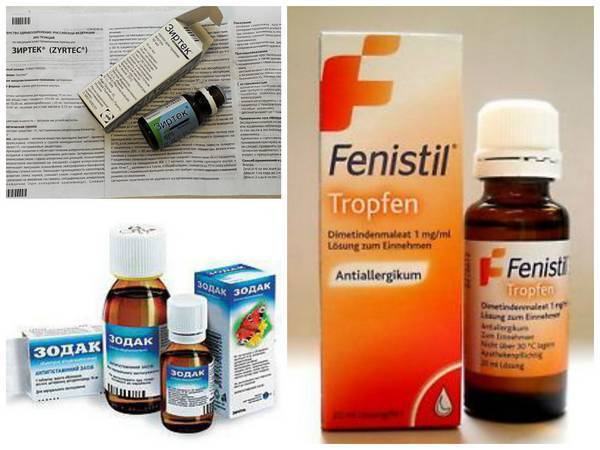
Some children are prescribed the drug by their pediatrician as preparation for routine vaccination. For other children, allergy drops for children were recommended for rashes, runny nose, and dry cough. All unpleasant symptoms disappear in a short period of time, the child behaves calmly - stays awake during the day and sleeps well at night.
Antihistamine drops for allergies are very convenient to use for infants. You can add the recommended amount to a bottle of food, water or juice. Another way is to drop 10–15 undiluted Fenistil liquid into a spoon and give it to a child aged 1–6 years. The taste is not cloying and does not cause any unpleasant sensations.
Reviews of fenistil note that the product is well tolerated by children and adults. The drug has few contraindications and causes almost no side effects. Sometimes drowsiness occurs, rarely digestive disorders, dry throat and/or mouth appear. The most important contraindications for treatment with the drug "Fenistil" are the age of the child less than 1 month, hypersensitivity to the components of the drug, bronchial asthma
The allergy drug Erius works using a substance called desloratadine. From a pharmacological point of view, Erius is an improved version of Loratadine, only its metabolites are more active
You don't know what to choose - Erius or Zyrtec? Please note that the effectiveness of these medications will be approximately the same. Patients note that, on average, the effect of Erius manifests itself faster, that is, after taking the pill, a person returns to normal faster
The manufacturer recommends using the drug for allergies with symptoms of urticaria and runny nose. It reduces itching, eliminates rashes from the skin, the patient stops sneezing and experiencing discomfort in the nasopharynx.
Medicines for children
Despite the fact that Zyrtec and Zodak are available in pharmacies without a prescription, treatment of children for allergic reactions with such medications should be carried out strictly as prescribed by a doctor. It is he who prescribes the dosage regimen and dosage during the consultation.
In addition, the course of treatment with these antiallergic drugs should be carried out strictly under medical supervision. This is explained by the fact that children’s immunity is not yet fully formed, and the effect of allergens on a fragile body can be unpredictable. This is especially true for children under five years of age.
Since both medications have the same active substance, they can be prescribed equally to young patients who suffer from the following diseases:
- hay fever;
- atopic dermatitis;
- asthma.
Despite the same active substance, the drugs contain various auxiliary components, which also need to be taken into account when prescribing to children.
Thus, the Zodak consists of the following additional elements:
- metal parahydroxybenzoate;
- glycerol;
- propyl parahydroxybenzoate;
- propylene glycol;
- sodium saccharinate dihydrate;
- sodium acetate tridigrate;
- glacial acetic acid;
- purified water.
In turn, the composition of Zyrtec is distinguished by the presence of elements such as sodium acetate, methylparabenzene and propylparabenzene.
Therefore, before prescribing one of these medications to children, you need to make sure that they do not have hypersensitivity to these components.
When it comes to side effects, the two drugs may behave differently.
When taking Zodak, children may experience the following adverse reactions:
- lethargy or, conversely, excessive excitement;
- decreased psychomotor abilities, therefore, children taking this drug are not recommended to ride a bicycle or other children's mechanical device;
- the appearance of nausea, in rare cases vomiting;
Zyrtec, unlike its analogue, has fewer side effects, which appear exclusively in case of overdose and are expressed in the appearance of dry mouth or drowsiness.
The two antiallergic drugs have the same dosage, which is:
- for adults and adolescents over twelve years of age – 1 tablet or 20 drops of solution once a day;
- for children from six to twelve years old – half a tablet or 10 drops of solution twice a day;
- for children from two to six years old – a quarter of a tablet or 5 drops of a solution twice a day;
One should not lose sight of the fact that Zodak can be used in children over two years of age, while Zirtec can be prescribed in children over one year of age.
There are exceptions when the attending physician, in order to increase the medicinal properties of a particular drug, can reduce or increase the dose for each patient individually.
As can be seen from the above characteristics, both drugs are equally effective, and also have the same indications and dosage for use in children. However, Zyrtec has fewer side effects, and therefore it is prescribed by doctors more often than its counterpart.
"Zyrtec" and "Zodak": contraindications, side effects
"Zyrtec" and "Zyrtec" have the same. They are not taken, lactation, hypersensitivity to components
These drugs are prescribed with caution to the elderly. Syrup and drops are not recommended for use up to six months, and for those under two years of age
The side effects of Zyrtec and Zodak are the same: drowsiness, dry mouth, allergic reactions, migraines, dizziness, discomfort in the gastrointestinal tract.
During treatment with Zodak or Zyrtec, you should refrain from performing potentially dangerous activities that require rapid psychomotor reactions and increased concentration (for example,). Both drugs are sold without a doctor's prescription.
Home » Childbirth » Zodak or Zyrtec – which is better for the child? What is the difference between Zodak and Zyrtec.
Efficacy of drugs
According to clinical trials, it was found that Zodac and Zyrtec have good anti-allergic properties on the body. And therefore their effectiveness is practically no different. Both the first and second drugs cope well with allergic reactions at any stage of occurrence.
In addition, they are well accepted by the body, and the maximum concentration of active components in the blood is reached within five minutes.
There are Zyrtec tablets and drops:
- Each tablet has a score line and double-sided engraving: ZYRTEC and 10.
- Zyrtec drops have a characteristic vinegary odor and sweetish taste. The drops come with a dispenser. It is designed to easily measure the required amount of solution for a child or adult. It is noted that when taking the drug, children do not experience any unpleasant taste sensations.
The medicine has a rapid effect: in half of patients it occurs within 15-20 minutes after administration, regardless of the form in which it is used.
Manifestations of adverse reactions
When Zyrtec is prescribed, side effects from organs and systems are extremely rare. The drug is well tolerated, does not accumulate, does not cause addiction, drowsiness and lethargy, and does not adversely affect the heart and liver.
Even with existing liver pathology, no special dose adjustment is required, since the drug is excreted through the kidneys.
Side effects do not depend on the form of the drug. Similar disorders can occur when taking both drops and tablets:
- fainting, headaches, drowsiness, tremor, paresthesia;
- asthenic conditions in the form of weakness, general malaise, unmotivated fatigue;
- itching and rash like urticaria;
- heartbeat;
- diarrhea, dry mouth, weight gain;
- pharyngitis, laryngitis.
Characteristics of the drug Zodak
It is an antiallergic agent, the action of which is due to the blocking of histamine receptors. In addition, it inhibits the development of allergic reactions and also facilitates their course. The effect occurs 20 minutes after application and lasts about a day . Available in the form of film-coated tablets, drops in a bottle for oral administration.
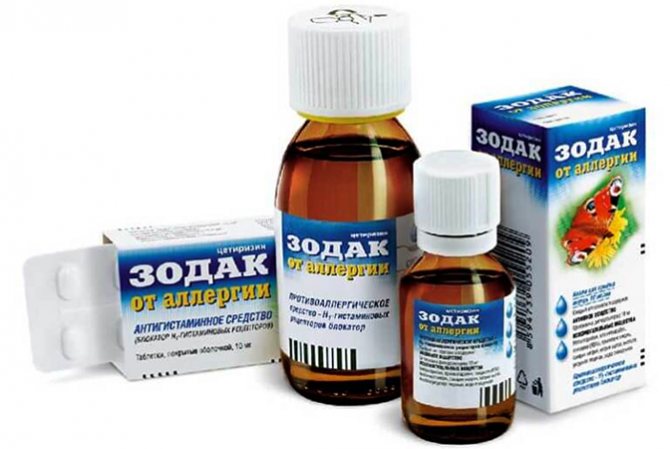
Indications for use are:
- Year-round, seasonal allergic rhinitis with accompanying itching, sneezing, runny nose.
- Allergic conjunctivitis.
- Chronic idiopathic urticaria.
Contraindications include:
- Hypersensitivity to the constituent components.
- End-stage renal failure.
- Hereditary disorder of the absorption of monosaccharides in the stomach and intestines.
- Children under six years of age.
- Pregnancy period.
Use with extreme caution during breastfeeding, with chronic kidney pathologies, epilepsy, prostatic hyperplasia, spinal cord lesions, and in the elderly.
Based on the research results, the following side effects were identified:
- Drowsiness, increased fatigue, dizziness, migraine.
- Aggression.
- Increased heart rate.
- Muscle pain.
- Increase in body weight.
- Difficulty urinating.
- Dry mouth.
- Increased activity of liver parameters, bilirubin.
- Nausea, stomach pain, diarrhea.
- Inflammation of the mucous membrane of the nose and pharynx.
- Decreased platelet count.
As a rule, after stopping the medication, all negative consequences are eliminated and the indicators return to normal. If side symptoms persist for a long time, you should consult a doctor.
In case of overdose, there is a negative effect on the central nervous system. You should immediately perform gastric lavage and induce vomiting. The use of activated carbon is also recommended.
